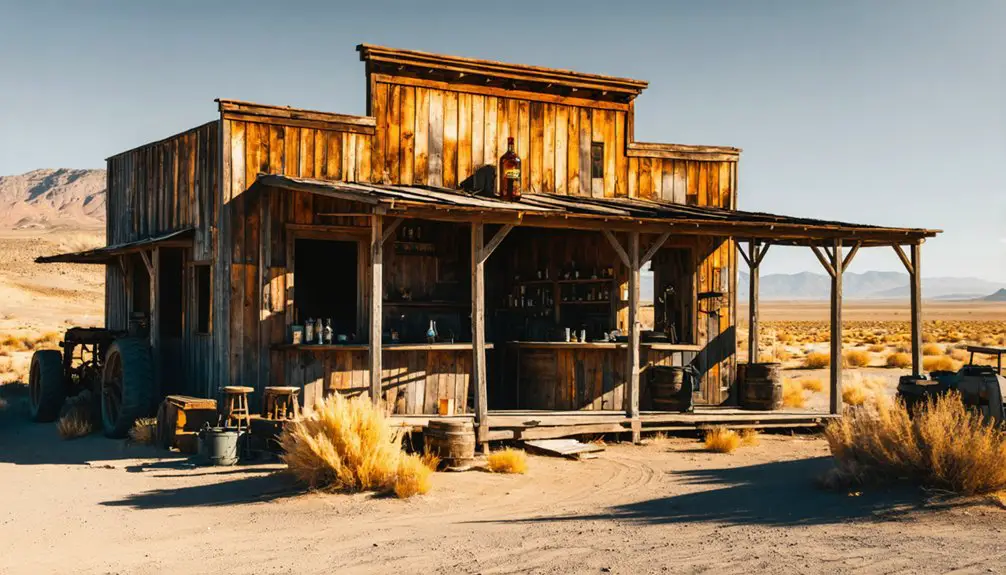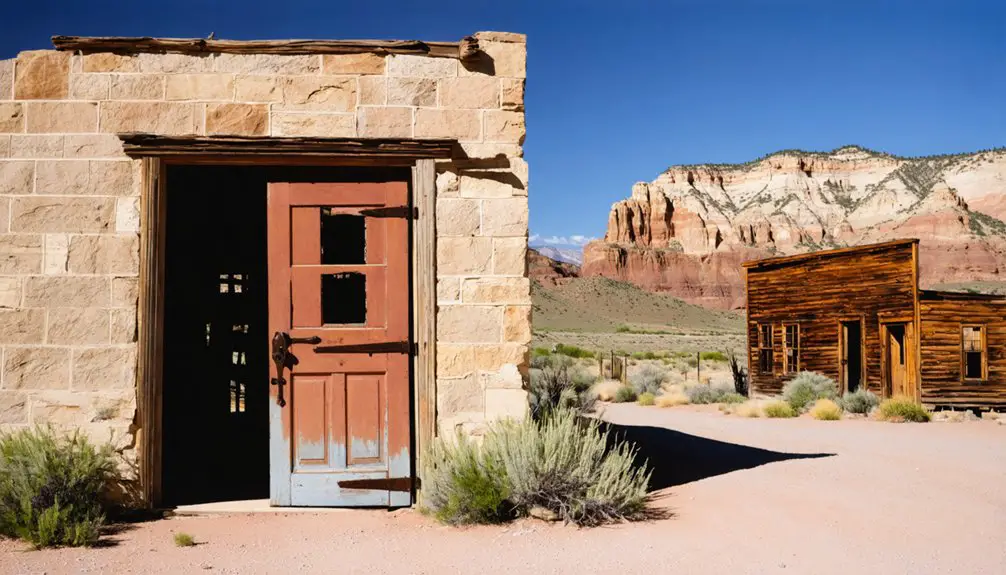You’ll discover Emery County’s most fascinating ghost towns, remnants of Utah’s mining history from the early 1900s. From Mohrland’s thriving coal empire of 1,000 residents to Woodside’s railroad heritage and Desert Lake’s agricultural pioneers, each abandoned settlement tells a unique story of boom-and-bust cycles. These towns, like Connellsville and Victor, faced harsh desert conditions and economic challenges, leaving behind artifacts and structures that reveal the untold tales of Utah’s industrial frontier.
Key Takeaways
- Mohrland, established in 1906, grew to 1,000 residents as a thriving coal mining town before becoming abandoned by 1935.
- Woodside, founded in 1881 near Price River, features historic buildings, a cold-water geyser site, and is currently for sale.
- Desert Lake, established in 1888, represents early pioneers’ struggles with irrigation and agricultural development in harsh desert conditions.
- Connellsville attempted industrial-scale coal processing but failed by 1878, with its remains now submerged beneath Electric Lake.
- Victor flourished through uranium and coal mining from the 1940s-1970s before being abandoned, leaving only a cemetery as evidence.
The Rise and Fall of Mohrland’s Coal Empire
While coal mining in Cedar Creek Canyon initially served local heating needs before 1896, Mohrland’s story truly began in 1906 when William and Erin Howard opened the first significant mine in the area.
After changing hands, the mine became part of Castle Valley Fuel Company in 1909, transforming into a thriving company town named from its investors’ initials. The mine utilized electric locomotives for hauling coal throughout its operations.
By 1920, Mohrland’s economy was booming with 1,000 residents, 200 houses, and amenities including a hospital, school, and amusement hall. The company amusement hall featured a bowling alley, confectionary, and space for dances and picture shows.
At its peak, Mohrland flourished as a complete community, offering residents everything from healthcare to entertainment in their mining town home.
Mining safety remained a constant concern, with 17 fatalities recorded between 1910-1938, leading to mandatory first aid training.
The town’s prosperity wouldn’t last – plummeting coal prices forced an abrupt closure in 1925, and by 1935, the mine’s connection to Hiawatha sealed Mohrland’s fate as a ghost town.
Woodside: A Desert Mining Settlement Lost to Time
Not far from Mohrland’s coal-driven rise and fall, another Utah settlement carved its own distinct path through history.
You’ll find Woodside’s story beginning in 1881 when prospector Henry H. Hutchinson settled near the Price River, drawn by tales of a Spanish gold mine. The town quickly evolved from a railroad water stop into a bustling community of 328 residents by 1910, complete with hotels, saloons, and stockyards.
What makes this ghost town truly unique is its vanished cold-water geyser that once shot 75 feet high, and the tunnels where Butch Cassidy reportedly hid after his 1897 train robbery. The area once thrived with sugar beets and vegetables, showcasing its agricultural heritage.
The property, currently on the market for 3.9 million dollars, includes two free-roaming llamas and a historic service station.
While Woodside’s historical significance remains, its population dwindled after the railroad’s departure in the 1920s and devastating droughts of the 1930s.
Today, this 700-acre property stands as a reflection of the Wild West’s fleeting nature.
Life in the Mining Hub of Victor
When you’d visit Victor during its mining heyday from the 1940s through the 1970s, you’d find a bustling community centered around uranium and coal extraction, particularly at operations like the Beehive Mine.
You’d see miners and their families living in modest dwellings near the mining sites, working seasonal patterns that often combined mining in winter with farming in summer. The harsh environment of the Colorado Plateau made life challenging for these determined residents.
Your daily life would revolve around the tight-knit mining culture, where the demands of extracting high-grade ore shaped everything from housing choices to community gatherings. The Beehive mine’s sale to Utah Power in 1972 brought increased employment opportunities to the area.
Mining Operations and Community
Although Victor began as a modest mining settlement, it rapidly transformed into a bustling hub of gold mining activity in the late 19th century. By 1899, you’d find over 10,000 residents drawn to the rich gold veins beneath the town, with the Gold Coin mine exemplifying the area’s mineral wealth. The total gold production from the district exceeded 12.5 million ounces.
The railroad’s arrival in 1894 connected Victor’s mines to broader markets, while engineering marvels like the Carlton Tunnel helped solve persistent flooding issues. Like many mining operations of the era, the town followed the model of company-owned mining towns to house its workers.
You’d witness complex labor relations unfold through major strikes in 1894 and 1903, where miners clashed with management, requiring state military intervention. The working-class character of Victor contrasted sharply with neighboring Cripple Creek, as miners made their homes here while owners and investors settled elsewhere.
Despite challenges like water scarcity and devastating fires, the community’s resilience prevailed until the mines’ closure in 1962.
Daily Life and Hardships
Life in Victor presented stark contrasts to typical mining settlements, as residents faced unique agricultural challenges rather than industrial hardships.
You’d find modest homes built for farming families who’d relocated from Desert Lake after alkaline soil contamination devastated their previous settlement. While mining towns enjoyed company-provided amenities, Victor’s residents struggled with persistent sand dunes damaging their farmland and harsh desert conditions threatening their crops. Similar to the devastating impact of natural disasters that destroyed Thistle in 1983, Victor’s environment proved too challenging to overcome.
The community’s resilience centered around their schoolhouse, where children gathered for education and families found social connection despite their isolation. Just as in Lark, strong community bonds developed through shared gatherings and social activities at the local schoolhouse.
Unlike mining communities with diverse economic foundations, Victor’s farming challenges proved insurmountable. Drought conditions, poor soil quality, and limited water access ultimately forced families to abandon their homes by 1920, leaving only the cemetery as proof of their brief but determined settlement.
Connellsville’s Industrial Legacy
Founded in 1874, Connellsville emerged as the pioneering settlement in Utah’s Emery County, drawing its name from Pennsylvania’s renowned coking center.
You’ll find its story marked by ambitious industrial aspirations, as settlers transformed local coal mining from subsistence to commercial scale.
The town’s coke production faced significant industrial challenges. Workers spent 72 hours cooking coal in specialized brick ovens, but poor coal quality and the absence of railway connections ultimately doomed their efforts.
Despite tireless efforts to transform coal into coke, primitive conditions and inferior materials sealed Connellsville’s industrial fate.
Despite the dedicated work of several dozen miners and coke oven workers, the settlement couldn’t overcome these obstacles. By 1878, Connellsville’s industrial dreams had faded, and the town was abandoned.
Today, you’ll find its remnants preserved beneath Electric Lake’s waters, a reflection of early industrial innovation on Utah’s Wasatch Plateau.
Desert Lake: Surviving the Harsh Frontier

While Connellsville’s fate rested beneath lake waters, Desert Lake’s story began in 1888 when three determined pioneers – Hans P. Marsing, Charley Winder, and their companion – staked their claim after working on the Cleveland Canal.
You’ll find their settler challenges were immense: they built log cabins, constructed an earthen dam, and developed irrigation systems to transform the barren desert.
Mining Heritage Preservation in Emery County
Throughout Emery County’s rich coal mining heritage, which began in the early 1900s, pioneering families like the Howards and Granges staked their claims in areas such as Mohrland, laying the foundation for the region’s industrial legacy.
You’ll find this history meticulously preserved at the Emery County Archives, where heritage conservation efforts maintain an essential link to the area’s mining past.
Community involvement has been significant in preserving these stories, with local families donating mining documents, photographs, and artifacts.
The Archives’ collection includes detailed records of mining operations, from the church-operated Deseret Mine to the bustling town of Mohrland, which thrived until 1935.
While mining’s economic influence has waned, its cultural impact endures through carefully cataloged oral histories and documents that you’re welcome to explore at the Archives.
Frequently Asked Questions
Are Any of Emery County’s Ghost Towns Accessible by Regular Passenger Vehicles?
Like browsing Netflix, you’ll find Emery County’s accessibility varies. You can reach the semi-ghost town of Emery in your sedan, but most other sites need high-clearance vehicles or off-road capabilities.
What Dangerous Wildlife Might Visitors Encounter in These Ghost Town Areas?
You’ll need to watch for rattlesnakes, mountain lions, black bears, scorpions, and tarantulas. For wildlife safety, stay alert during dawn and dusk when animal encounters are most likely.
Do You Need Permits to Explore or Photograph These Ghost Towns?
Like a curious explorer stepping into the past, you don’t need permits for casual exploration or photography. However, you’ll require permission for commercial shoots or if accessing ghost towns on private property.
Is Artifact Collecting Allowed at Any of These Abandoned Sites?
You can’t legally collect artifacts at these sites due to strict collecting regulations. Preservation laws protect these historic treasures on federal, state, and private lands, requiring permits for any removal.
Which Ghost Towns Have Cellular Service for Emergency Communications?
Like tendrils reaching from Castle Dale’s towers, you’ll find cellular coverage strongest near Woodside and Ferron. For emergency contacts, your best signals are in ghost towns closest to inhabited areas.
References
- https://en.wikipedia.org/wiki/Category:Ghost_towns_in_Emery_County
- https://www.visitutah.com/things-to-do/history-culture/ghost-towns
- https://jacobbarlow.com/2020/03/03/ghost-towns-in-utah/
- https://en.wikipedia.org/wiki/Mohrland
- https://jacobbarlow.com/tag/ghost-towns/
- http://historicalpreservation.blogspot.com/2011/08/mohrland-in-1906-william-howard-and-his.html
- https://utahrails.net/utahcoal/mohrland.php
- https://ogm.utah.gov/wp-content/uploads/2023/09/Rowleyfinal.pdf
- https://utahrails.net/pdf/Thirty-Years-of-Coal-Mining.pdf
- https://jacobbarlow.com/2013/11/27/woodside-utah/



